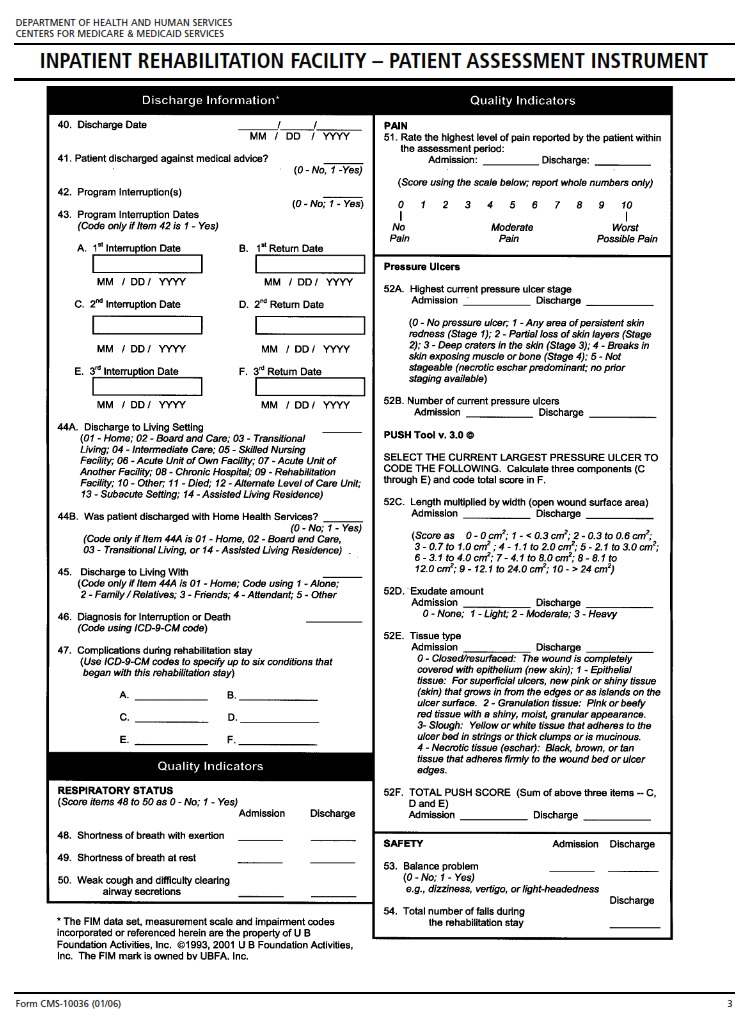CMSFORM.ORG – CMS 10036 – Inpatient Rehabilitation Facility-Patient Assessment Instrument – In the world of healthcare, where precision and thorough assessment are paramount, one instrument stands out as a beacon of comprehensive patient evaluation – CMS 10036, the Inpatient Rehabilitation Facility-Patient Assessment Instrument. Designed to delve deep into the intricacies of a patient’s condition and rehabilitation potential, this tool is not just a formality but a window into personalized care and targeted treatment strategies. Imagine stepping into the realm of inpatient rehabilitation armed with a meticulously crafted roadmap that guides healthcare providers through every aspect of a patient’s journey towards recovery. CMS 10036 is not just an assessment tool; it is a dynamic compass that navigates healthcare professionals through the complex terrain of inpatient rehabilitation with precision and purpose. Let’s embark on an enlightening exploration of this essential instrument and uncover how it revolutionizes the way we approach patient care in rehabilitation facilities.
Download CMS 10036 – Inpatient Rehabilitation Facility-Patient Assessment Instrument
| Form Number | CMS 10036 |
| Form Title | Inpatient Rehabilitation Facility-Patient Assessment Instrument |
| Published | 2006-01-01 |
| O.M.B. | 0938-0842 |
| File Size | 442 KB |
CMS 10036 - Inpatient Rehabilitation Facility-Patient Assessment Instrument (606 downloads )
What is a CMS 10036?
The CMS 10036, also known as the Inpatient Rehabilitation Facility-Patient Assessment Instrument, is a critical tool used in healthcare settings to assess and monitor patient progress during their stay in an inpatient rehabilitation facility. This assessment instrument helps healthcare providers gather essential information about the patient’s functional status, medical conditions, and rehabilitation needs. By documenting this data, providers can develop personalized treatment plans that aim to improve the patient’s overall well-being and quality of life.
One key aspect of the CMS 10036 is its focus on comprehensive evaluation across multiple domains such as mobility, self-care abilities, cognition, communication skills, and medical stability. This holistic approach allows healthcare teams to gain a thorough understanding of the patient’s current capabilities and limitations in order to tailor interventions that address specific areas of need. Furthermore, the use of standardized assessment tools like the CMS 10036 promotes consistency in documentation practices and facilitates communication among different members of the care team involved in coordinating the patient’s rehabilitation journey.
Where Can I Find a CMS 10036?
Searching for a CMS 10036 form can be a daunting task for many individuals working in the healthcare industry, especially those involved in inpatient rehabilitation facilities. However, there are several resources where you can find this essential document. One of the most convenient ways to access the CMS 10036 is through the official Centers for Medicare & Medicaid Services (CMS) website. Here, you can easily download the form and any associated guidance documents that may be helpful in completing it accurately.
Furthermore, healthcare organizations often maintain their own repositories of regulatory forms like the CMS 10036 for easy access by staff members. If you work in an inpatient rehabilitation facility, check with your facility’s regulatory compliance or medical records department to inquire about obtaining a copy of this important assessment instrument. Additionally, professional associations and industry forums dedicated to rehabilitation services may also offer resources and support for locating and using the CMS 10036 effectively. By leveraging these various sources, healthcare professionals can ensure they have access to all necessary documentation to comply with regulations and provide quality care to their patients.
CMS 10036 – Inpatient Rehabilitation Facility-Patient Assessment Instrument
The Inpatient Rehabilitation Facility-Patient Assessment Instrument (CMS 10036) plays a crucial role in ensuring that patients in rehabilitation facilities receive the appropriate level of care tailored to their individual needs. By assessing various factors such as functional status, cognitive abilities, and medical needs, this instrument helps healthcare providers develop comprehensive treatment plans that aim to improve patients’ outcomes and quality of life.
One key aspect of CMS 10036 is its emphasis on patient-centered care, where the focus is not only on treating the underlying conditions but also on addressing the individual’s goals and preferences. This person-centered approach fosters a collaborative relationship between the patient and healthcare team, leading to more effective rehabilitation outcomes. Additionally, using standardized assessment tools like CMS 10036 allows for consistent data collection and evaluation, helping facilities track progress over time and make informed decisions regarding treatment strategies.
Overall, CMS 10036 serves as a valuable tool for inpatient rehabilitation facilities by guiding assessments, facilitating personalized care plans, and promoting ongoing monitoring of patient progress. Embracing this instrument can enhance the quality of care provided to individuals undergoing rehabilitation while supporting a holistic approach that considers both medical needs and personal aspirations.


